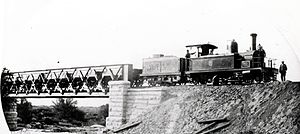CGR 2nd Class 2-6-2TT

CGR 2nd Class 2-6-2TT no. M26, with tender and "front porch railings", Fish River Bridge, c. 1881
|
|||||||||||||||||||||||||||||||||||||||||||||||||||||||||||||||||||||||||||||||||||
|
|||||||||||||||||||||||||||||||||||||||||||||||||||||||||||||||||||||||||||||||||||
|
|||||||||||||||||||||||||||||||||||||||||||||||||||||||||||||||||||||||||||||||||||
|
|||||||||||||||||||||||||||||||||||||||||||||||||||||||||||||||||||||||||||||||||||
|
|||||||||||||||||||||||||||||||||||||||||||||||||||||||||||||||||||||||||||||||||||
| Type and origin | |
|---|---|
| Power type | Steam |
| Designer | Robert Stephenson and Company |
| Builder | Robert Stephenson and Company Avonside Engine Company Kitson and Company |
| Serial number | RS 2205-2210, 2332-2339, 2353 (engines), RS 2215-2217, 2221-2223 (tenders) Avonside 1110-1113, 1157-1158, 1193-1194, 1209-1210 Kitson 2038-2041 |
| Build date | 1875-1879 |
| Total produced | 29 (2 lost at sea) |
| Specifications | |
|---|---|
| Configuration | 2-6-2TT (Prairie) |
| Driver | 2nd coupled axle |
| Gauge | 3 ft 6 in (1,067 mm) Cape gauge |
| Leading dia. | 24 in (610 mm) |
| Coupled dia. | 38 in (965 mm) |
| Trailing dia. | 24 in (610 mm) |
| Wheelbase: • Engine |
20 ft 3 in (6,172 mm) |
| • Coupled | 8 ft (2,438 mm) |
| Wheel spacing (Asymmetrical) |
1-2: 4 ft 8 in (1,422 mm) 2-3: 3 ft 4 in (1,016 mm) |
| Length: |
|
| • Over couplers | 27 ft (8,230 mm) |
| Height | 12 ft (3,658 mm) |
| Frame type | Plate |
| Axle load | 9 LT 6 cwt 3 qtr (9,487 kg) |
| • Leading | 2 LT 9 cwt (2,489 kg) |
| • 1st coupled | 7 LT 13 cwt (7,773 kg) |
| • 2nd coupled | 9 LT 6 cwt 3 qtr (9,487 kg) |
| • 3rd coupled | 6 LT 17 cwt 1 qtr (6,973 kg) |
| • Trailing | 2 LT 9 cwt (2,489 kg) |
| Adhesive weight | 23 LT 17 cwt (24,230 kg) |
| Loco weight | 28 LT 14 cwt 4 qtr (29,210 kg) |
| Tender type | 2-axle |
| Fuel type | Coal |
| Fuel capacity |
Engine: 0 LT 15 cwt (0.8 t) Tender: 2 LT (2.0 t) |
| Water cap |
Engine: 650 imp gal (2,950 l) Tender: 900 imp gal (4,090 l) |
| Firebox type | Round-top |
| • Firegrate area | 11 sq ft (1.0 m2) |
| Boiler: |
|
| • Pitch | 5 ft 10 1⁄2 in (1,791 mm) |
| • Tube plates | 10 ft (3,048 mm) |
| Boiler pressure | 130 psi (896 kPa) |
| Safety valve | Salter |
| Heating surface | 750 sq ft (70 m2) |
| • Tubes | 692 sq ft (64.3 m2) |
| • Firebox | 58 sq ft (5.4 m2) |
| Cylinders | Two |
| Cylinder size | 15 in (381 mm) bore 20 in (508 mm) stroke |
| Valve gear | Stephenson |
| Train brakes | Clarke's chain brakes |
| Couplers | Johnston link-and-pin |
| Performance figures | |
|---|---|
| Tractive effort | 11,546 lbf (51.36 kN) @ 75% |
| Career | |
|---|---|
| Operators | Cape Government Railways |
| Class | 2nd Class |
| Number in class | 27 |
| Numbers | E17-E26, M5-M10, M25-M33, W1-W2 |
| Delivered | 1875-1879 |
| First run | 1875 |
The Cape Government Railways 2nd Class 2-6-2TT of 1875 was a South African steam locomotive from the pre-Union era in the Cape of Good Hope.
The first mixed traffic locomotives to enter service on the new 3 feet 6 inches Cape gauge mainlines of the Cape Government Railways were 2-6-2 Prairie type side-tank engines which were delivered between 1875 and 1879. Four-wheeled tenders were also acquired and the locomotives could be operated in either a tank or tank-and-tender engine configuration, as circumstances demanded. These locomotives were later designated the Cape 2nd Class.
In 1872, the Cape Government took over the operation of all railways in the Cape of Good Hope and established the Cape Government Railways (CGR). Shortly before, it had been decided to adopt the narrower 3 feet 6 inches gauge instead of the existing 4 feet 8½ inches broad gauge for all further railway expansions, since it would decrease the cost of construction through the difficult terrain which lay inland from the three major ports of the Cape of Good Hope at Cape Town, Port Elizabeth and East London. This narrower gauge is still known as Cape gauge.
Since the operational area within the Colony was so vast, the CGR was divided into three semi-autonomous systems. The Eastern System was headquartered in East London, with A.E. Schmid as Chief Resident Engineer and J.D. Tilney as Locomotive Superintendent. The Midland System was headquartered in Port Elizabeth, with D. Jackson Scott as Chief Resident Engineer and Mr. Edwards as Locomotive Superintendent. The Western System was headquartered in Cape Town, with W.G. Brounger as Chief Resident Engineer as well as Consulting Engineer for the whole CGR, and Michael Stephens as Locomotive Superintendent.
The first Cape gauge mainline locomotives to enter service on the CGR were delivered in 1875. An order for six 2-6-2T Prairie type locomotives was placed with Robert Stephenson and Company, followed by a separate order for six four-wheeled tenders. The Stephenson locomotives were numbered W1 and W2 for the Western system and M7 to M10 for the Midland System.
...
Wikipedia
